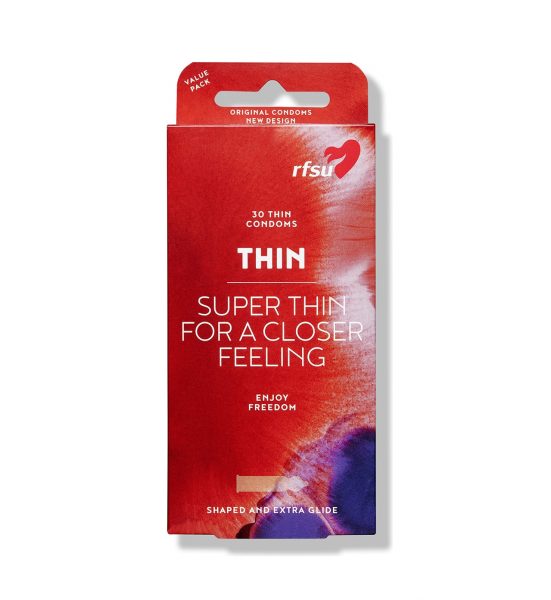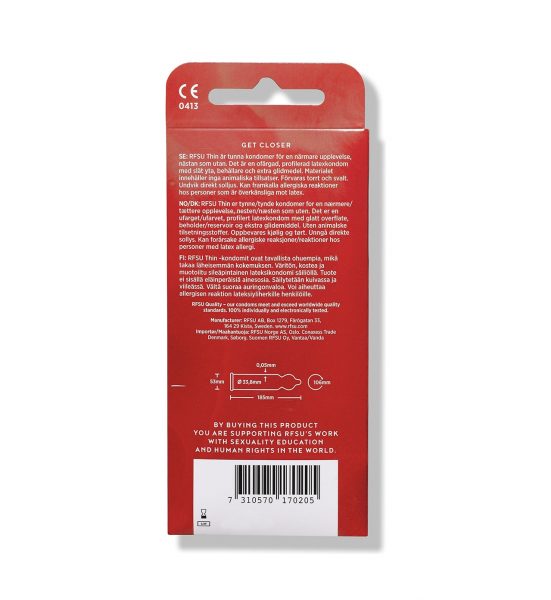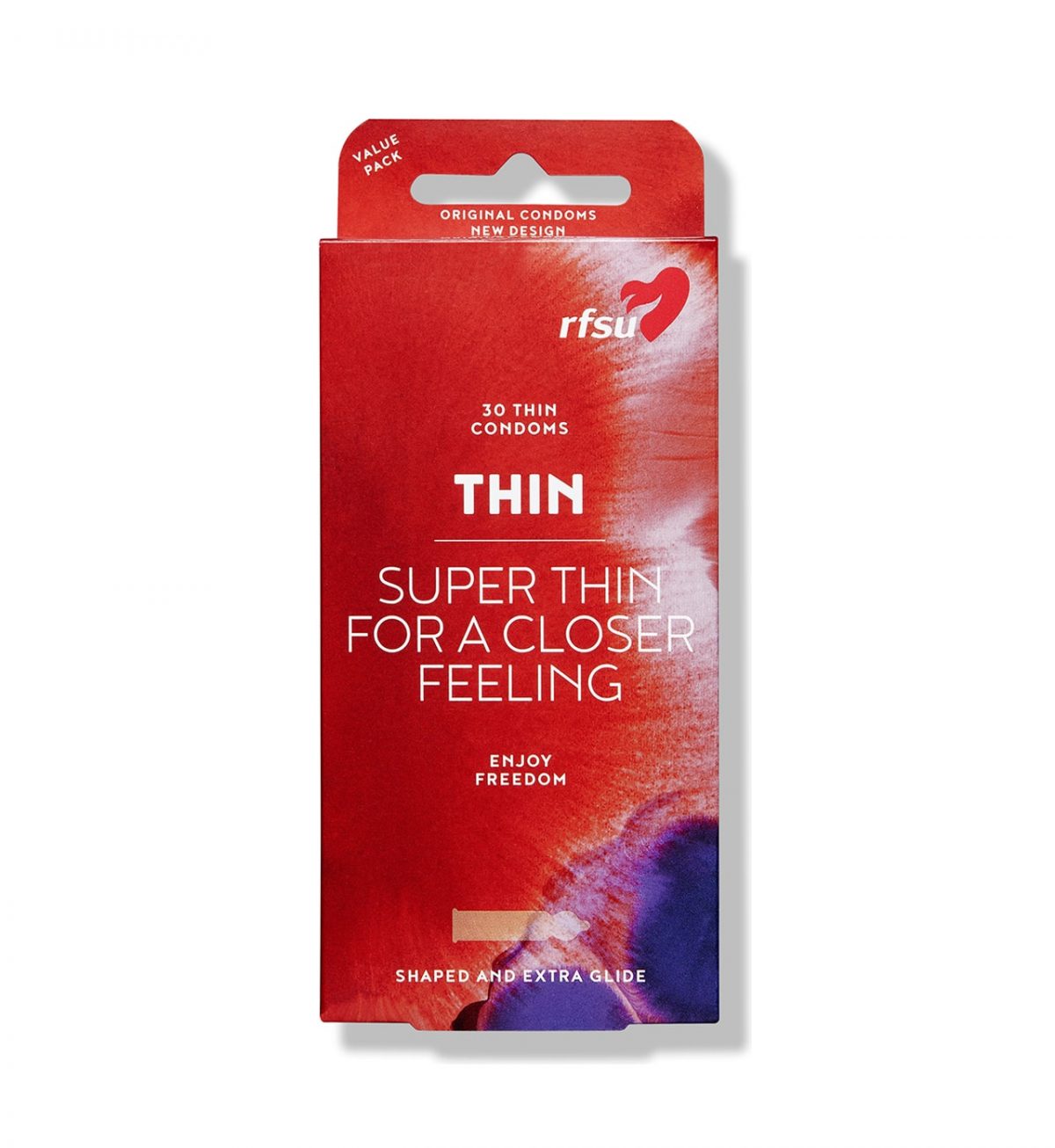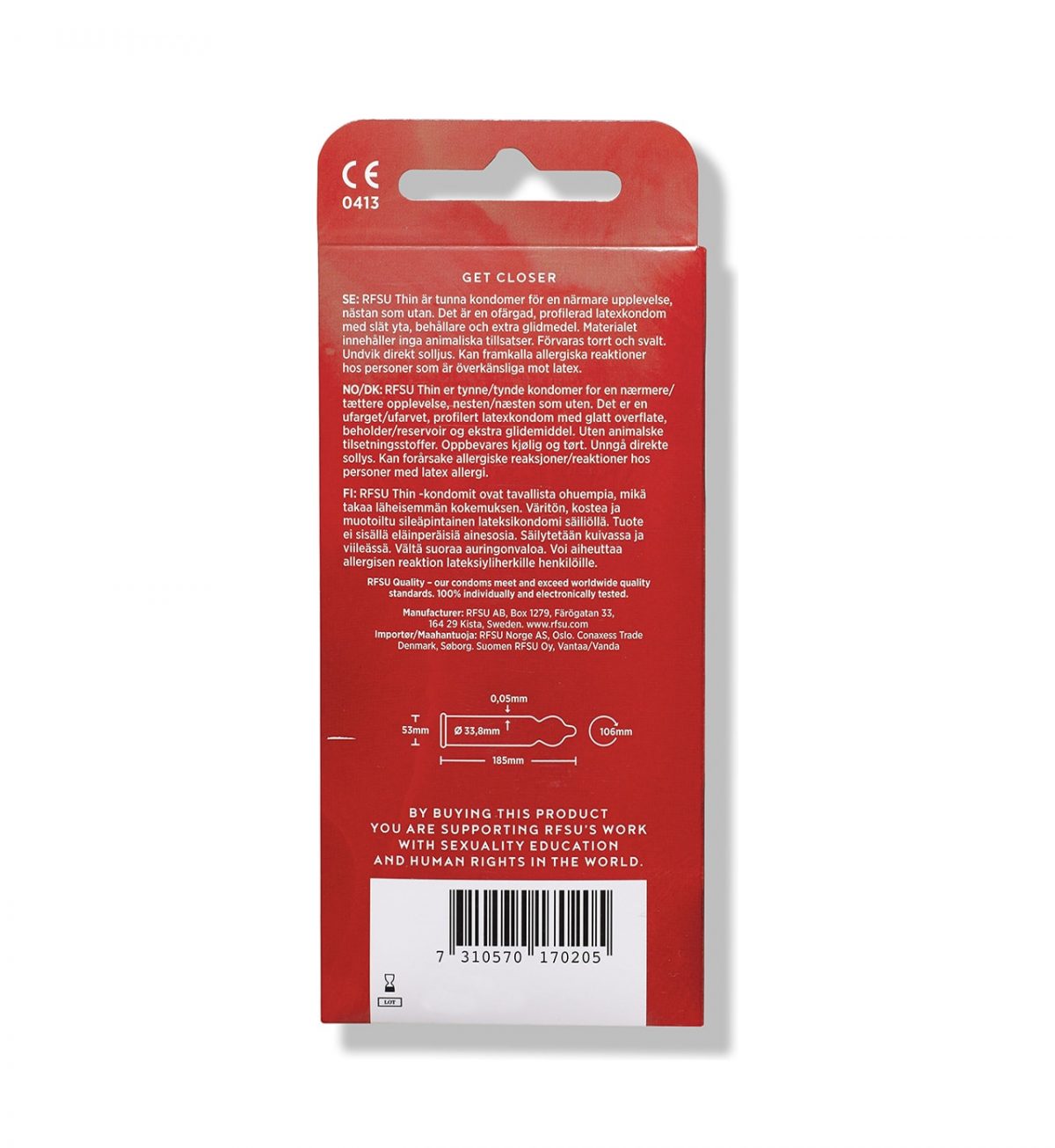-
Read more
![]()
- Latex condom
- Profiled
- Colorless
- Smooth surface
- With container
- Extra lubrication (silicone). If additional lubricant is desired, it must be water- and or silicone-based. RFSU has a large assortment to choose from. Do not use oil-based lubricant such as baby oil or Vaseline..
- Length: 185mm
- Width: 53mm
- Circumference: 106mm
- Diameter: 33,8mm
- Thinness: 0,05mm
- Condoms are the only contraceptives that protect against both pregnancy and sexually transmitted diseases.
- Hormone-free contraceptive.
- Used for protected sex (vaginal, anal, oral) or to avoid smearing.
- No contraceptive is 100% safe.
- The material contains no animal additives.
- May cause allergic reactions in people who are hypersensitive to latex.
- Store dry and cool, avoid direct sunlight.
-
How to use
- Open the package as shown in the drawing. Do not use sharp objects. First roll up the condom a bit so that it is clearly visible in which direction it should be rolled on.
- Squeeze the container between thumb and forefinger to remove any air. Before close contact with your partner, pull back the foreskin and roll on the condom carefully so that it is not scratched by a nail. When you use extra lubricant, it should be water- or silicone-based. RFSU has a wide range to start from. Do not use oil-based variants such as baby oil or Vaseline.
- Immediately after ejaculation, the penis is pulled and the condom is held in place so that no semen escapes. Use the condom only once. Do not flush down the toilet.
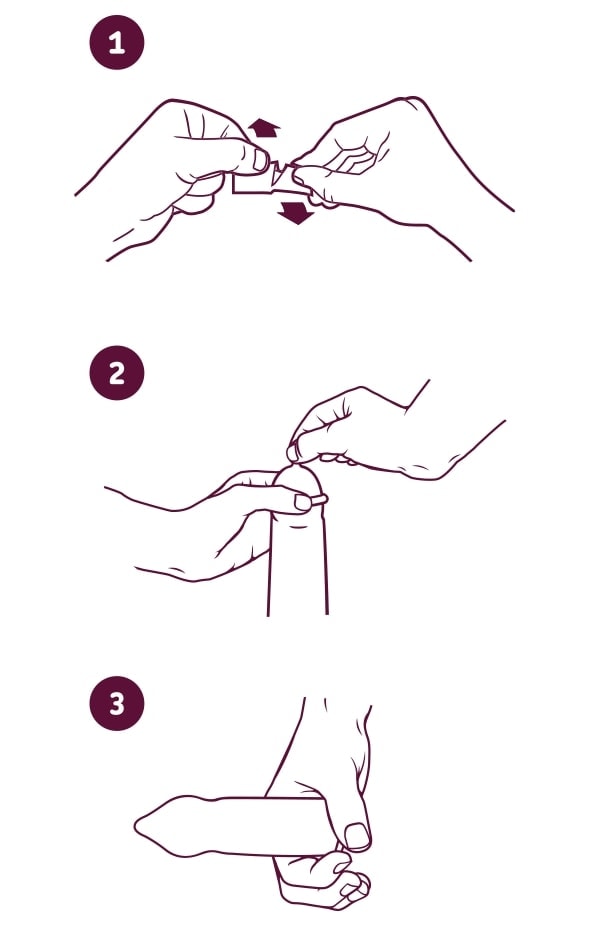
-
Which condom fits me best?
We describe the dimensions of our condoms by specifying length, circumference, width and diameter.
NB! The width is not the same as the diameter. The width measurement applies when the condom is flat. In addition to these measurements, we also indicate how thin the condom is.
All measurements are in millimeters.
In the top illustration, the condom is 0.06 mm thin, the width is 49 mm, the circumference is 98 mm, the diameter is 31.1 mm, and the length is 175 mm.
Tight is the smallest condom in terms of size.
Sensitive and Grande XL are the two largest condoms in terms of size, although they have slightly different shapes and properties
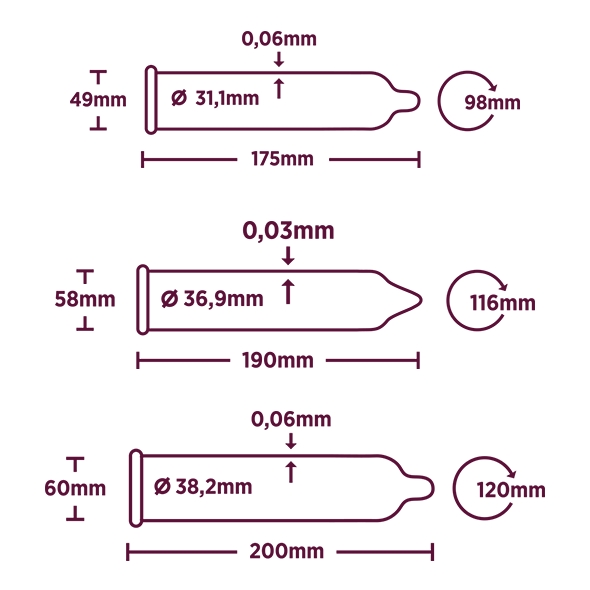
- Fact sheet
-
Q&A
How are condoms made and what are they made of?
Condom production begins on large rubber plantations in subtropical climates. Tall trees grow there that contain latex, liquid rubber. The trees are as tall as palm trees and grow in long rows in the hot sun. Most of the latex rubber is used for car tires and hoses, but a small part goes into condom production.
When bottling the latex, a long cut is made around the stem. Just below the cut, a small container is suspended into which the latex flows. The latex is a white viscous liquid. Once tapped from the trees, it is refined and condensed into a 60 percent concentrate. It is then shipped to the condom factory.Before manufacturing, density, stability and purity of the latex are checked. Once this is done, the various chemicals are mixed with the latex rubber. The mixture is then ground down to a cohesive mass in a mill for the next stage, vulcanization.Vulcanization is the most important part of condom production – thanks to this, condoms are heat resistant and retain their elasticity. The American Charles Goodyear accidentally discovered the vulcanization process in 1839. He was trying to improve the rubber’s durability by mixing different chemicals with the rubber. One day, while he was mixing sulfur with latex, a splash landed on a hot stove in his laboratory. The heat from the stove gave the latex mixture a new, hard-wearing texture. The strong “weatherproof” rubber had been created. The name Goodyear is most familiar to people thanks to the car tire manufacturer of the same name. It is thanks to the vulcanization process that condoms can be made so thin.When the latex mass has been completed, the mass is molded into condoms. The casting is similar to candle casting. A machine contains glass molds that are carefully dipped into the latex mass, dry, and then dipped again a couple of times. The latex flows downwards, towards the top of the condom, making it slightly thicker and stronger than the rest of the condom. The top is also often the part of the condom that experiences the most friction when being used.After casting, the condoms are washed and dried and then powdered with talc to prevent them from sticking together. Then they are unrolled and placed on new steel molds. An electric current is used to test if there are any holes in the condom, a test carried out on every single condom. Condoms are tested, packaged and distributed at RFSU’s factory and laboratory.
How long have condoms been around and what were they made of before latex?
People have been using condoms for thousands of years, although the material has changed greatly over that time. About 2000 years ago, the Chinese used oiled tissue paper condoms. The Japanese are said to have used leather condoms. For a long time in Europe, linen cloth was used to put on the glans, but it chafed and was soon replaced by pig caecum and fish bladder. The answer to how to avoid unwanted pregnancies has long been sought in the animal world. Long before the time of the condom, a spermicide made from crocodile feces was used in ancient Egypt. It was considered completely safe.Attitudes on condoms changed in the 16th century. Then Columbus’ men brought syphilis to Europe from Haiti, and suddenly they became necessary once again. Haitian Indians were resistant to syphilis because they had the disease as children. But Columbus’ men were infected, and at the time syphilis was a painful, deadly disease.It took a long time before condoms were really accepted. Neither in Germany nor in England did they call the condom by its proper name during the 18th century. Instead, they were known as “French letters” in England and “English caps” in Germany – expressions that were used well into the 20th century. French court physician Astruc is probably the originator of this. He wrote the following: “He who is about to have intercourse puts his penis inside as if in an envelope, to protect himself, in the same way as against the dangers that an uncertain battle can bring.”Great 18th century seducer Giacomo Casanova was a heavy consumer of animal gut condoms. He used to blow up his pet condoms to make sure there were no holes in them.Condom’s big breakthrough came at the end of the 18th century. England’s King Charles II had a reputation as a ladies’ man and had many children in the countryside, which was considered very inappropriate. Therefore, Charles tasked a doctor with finding a protection. The doctor’s name is said to have been Condom, and he would have suggested to the king to use a bag on his penis.If the story is true, Mr. Condom can be considered to be the father of the modern condom. Those who don’t believe the story of Mr. Condom are more aware that the condom got its name from the Latin word for container, “condus”.Sweden’s oldest preserved condom can be found at the History Museum in Lund. It dates from 1813 and comes with a special instruction manual. It says that before use, the condom must be boiled in milk and then powdered with flour.We have a tire manufacturer to thank for today’s condoms. In 1839, Charles Goodyear invented the vulcanization method. It turned sticky raw rubber into dry and elastic rubber. In addition to car tires, it became possible to use it to make rubber condoms. These were stretchable and cheaper to manufacture than intestinal condoms. Thirty years later, condoms began to be manufactured and distributed in earnest. When there was talk of birth control around 1900, condoms were used than ever before. But it also increased condom resistance. In 1911, the Contraceptives Act was introduced in Sweden, a law that prohibited information about condoms and all other contraceptives. Condoms were seen as a threat to marriage and the family. Another argument was that they helped encourage prostitution.In Sweden, you could buy condoms made from animal intestines right into the 1930s. The method of making condoms was further developed in the 1930s, as they became cheaper, thinner and more stretchy. The medical profession finally succeeded in convincing the Riksdag that condoms were the only protection against venereal infection. The Contraceptives Act was repealed in 1938, but the veil of secrecy over them endured. Condoms were sold under names such as “rubber goods”, “medical supplies” and “controlled goods” until 1959, when condom dispensers were introduced.The last vestiges of the law of the Contraception Act were repealed in 1970 when it became legal to sell, advertise and use condoms. Birth control pills had been approved as a contraceptive and in the mid-1970s they had their big breakthrough. This led to the use of condoms being halved in ten years. People could enjoy themselves without “carbon paper”, but with fewer condoms being used, other setbacks occurred, including a sharp increase in venereal diseases.RFSU began to market condoms using humorous campaigns and focused on the huge spread of venereal diseases. One of the most high profile campaigns was “Tonight 80 Swedes get gonorrhea – a condom is the only contraceptive that protects you!” Read more about our campaigns from the past under the heading RFSU.Our motto “condoms are the only contraceptive that protect you against both unwanted pregnancies and sexually transmitted infections” is still used today. In addition, condoms are the man’s only form of contraception.
Can you use condoms to have sex in a sauna. How are they affected by the heat? I know you shouldn’t store them in conditions that are too hot or in sunlight, but what about when you’re using them?
You are absolutely right that condoms should not be kept warm, but using them in a sauna isn’t dangerous. It is long-term storage in high heat that causes condoms to age faster than at room temperature, but even then, we are talking about degrees up to 50C, and a time perspective of about one year.
I accidentally froze a pack of condoms. The oil around them doesn’t seem to have frozen them, but what about their durability now?
You can relax. Condoms are not damaged by extreme cold. Just let them thaw at room temperature and they are ready to use. However, strong heat (sunlight, for example) is not recommended. Condoms are aged by heat and can lose elasticity, causing them to break. But as we said, the cold is not a problem.
How long does a condom last in the packet and what is the longest time span from manufacture to “best before” in years?
A condom has a shelf life of five years from manufacture. We write a “Best-before” date on the label on the package and the condoms are always manufactured 5 years before this date.
Which lubricant is on the condoms and what does it contain?
On all our condoms except 17006, it is 100% silicone-based lubricant. A drop of silicone lubricant is put on all condoms so that they do not dry out in the package and make them easier to roll on. The lubricant is pure silicone and contains no additives, such as glycerin.
I have read that casein from animal milk is used in the production of rubber and latex. Is that the case with your condoms?
No. Our quality manager confirms that our condoms do not contain any animal products and there is no animal testing either. Vegans can use RFSU condoms with a clear conscience.


